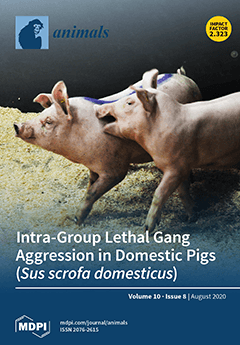The aquaculture industry is a fast-growing sector in Egypt; however, the progress of this industry is impeded by many challenges such as poor water quality and associated bacterial infections. Among others, Motile
Aeromonas Septicemia (MAS), caused by aeromonads, is among the most important
[...] Read more.
The aquaculture industry is a fast-growing sector in Egypt; however, the progress of this industry is impeded by many challenges such as poor water quality and associated bacterial infections. Among others, Motile
Aeromonas Septicemia (MAS), caused by aeromonads, is among the most important bacterial diseases affecting aquaculture due to its zoonotic potential. In the present work, motile aeromonads were isolated from water samples (
n= 8) and Nile tilapia (
n= 240) in four fish farms (farms I, II, III, and IV) in Kafr El-Sheikh province during the period March to August 2017. This step was followed by investigation of the prevalence and phenotypic, molecular, and histopathological characterization of aeromonads. In addition, antimicrobial susceptibility and virulence gene detection were analyzed. Interestingly, physicochemical water analysis revealed different ranges in relation to the fish farms and seasons. More importantly,
Aeromonas isolates were phenotypically identified in 33.3% and 12.5% from fish and water samples, respectively. The highest prevalence of motile aeromonads (46.7%) was recorded from farm IV, and only 12.5% of water samples were positive for them. Out of 80 isolates, 65 (81.25%) were molecularly identified at the genus level using gyrase B (
gyrB). The prevalence of the virulence genes detected in the isolated motile aeromonads was aerolysin (
aer), 52.2%; elastase (
ahp), 26.25%; hemolysin (
hyl), 35%; and lipase (
lip), 3.75%. The antibiogram profile revealed that the highest resistance of aeromonads isolates (80%) was recorded to chloramphenicol, kanamycin, and azithromycin. Meanwhile, lower resistance levels of 40%, 30%, and 20% were found for streptomycin, cefotaxime, and amoxicillin, respectively. The multiple antibiotic resistance (MAR) index values ranged between 0.27 and 0.82 of motile aeromonads isolates. Furthermore, the histopathological examinations of naturally diseased tilapia revealed widespread hepatocellular necrosis with diffuse, numerous rod-shaped bacteria in liver with melanomacrophages and lymphocytic depletion with edema and hemosiderosis in the spleen. Our findings provide an updated epidemiological baseline for future reference and highlight the likely role of the adverse impact of water quality in the outbreaks of motile aeromonads with special reference to virulence genes and antibiotic resistant traits.
Full article






